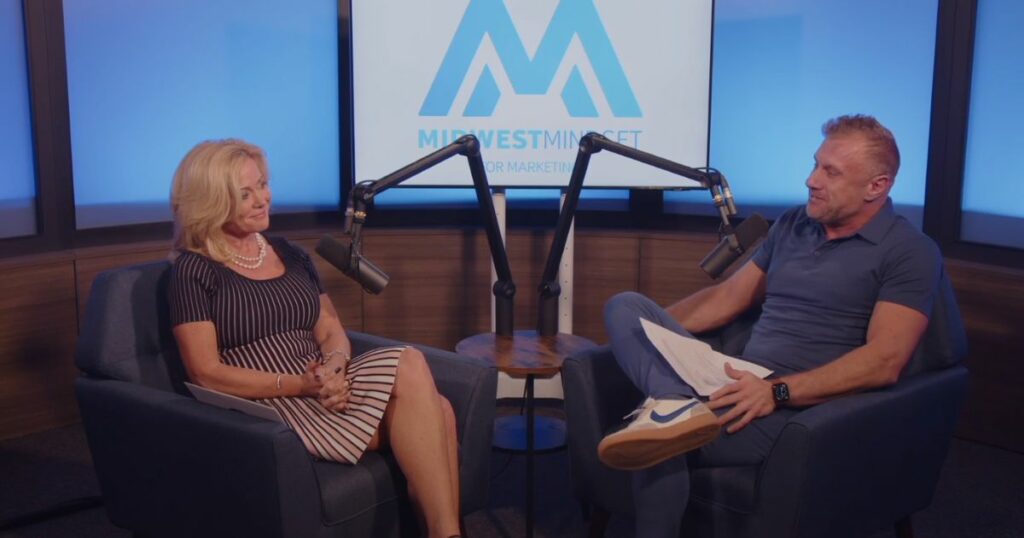Inbound VS Outbound Marketing: Do You Need to Pick One?
Inbound vs. outbound marketing, what exactly is it? Feeling swamped by the overload of marketing strategies available? Wondering which one will truly push your business to new heights? Fret not; you’re not alone!
Embark with us on a deep dive into the captivating world of inbound and outbound marketing for your local business in Omaha. These two influential marketing approaches, each boasting unique strengths and weaknesses, will ultimately guide your business toward the most effective strategy tailored to your needs.

Part One: Inbound VS Outbound Marketing
Welcome to the first part of our three-part series on inbound and outbound marketing, where we’ll uncover the importance of selecting the ideal marketing strategy to ensure your business success.
We’ve crafted this series to provide you with the knowledge needed to choose the best approach and make well-informed decisions. Here’s a quick overview of our series:
In this first part, we explore the fundamental differences between inbound and outbound marketing, their goals, tactics, and how they work together for a well-rounded strategy.

Part Two: What is Inbound Marketing?
The second part focuses on inbound marketing, discussing its core principles, tactics, and best practices for creating valuable content and nurturing leads.
Part Three: What is Outbound Marketing?
Lastly, we dive into outbound marketing, exploring its various tactics and how to balance it with inbound marketing for a winning combination.
By the end of this series, you’ll have a clear understanding of both strategies and be better equipped to choose the right approach for your business goals.
Let’s get started on this insightful marketing journey.
Inbound Marketing: Attract, Engage, and Delight
It’s a pull marketing strategy, as opposed to push marketing (which we’ll talk about soon). Some key elements of inbound marketing include blog posts, social media, and search engine optimization (SEO).
The beauty of inbound marketing lies in its ability to seamlessly connect with your target audience without disrupting their daily lives. By focusing on creating and sharing valuable content tailored to their interests, you can effectively draw them towards your brand organically.
This approach is all bout trust and credibility, as potential customers appreciate the value and authenticity you provide, and they begin to see your brand as a reliable source of information.

Also, incorporating Search Engine Optimization (SEO) into your inbound marketing strategy can significantly enhance your online visibility. By optimizing your content with relevant keywords, you can improve your search engine rankings, making it easier for potential customers to discover your products or services.
I remember when I first started using inbound marketing for my business. I was hesitant at first, thinking it wouldn’t be as effective as traditional marketing tactics like spectaculars, TV ads, and more.
I´ll be the first to admit I was wrong. Really wrong. My website traffic skyrocketed, and my brand awareness reached new heights. I knew I’d found a winner.
Outbound Marketing: The Traditional Approach
Now, let’s talk about outbound marketing.
This approach involves reaching out to potential customers directly, usually through tactics like cold calling, paid search, and cold email. It’s often referred to as push marketing because you’re essentially pushing your message onto people, whether they like it or not.
One benefit of outbound marketing is that it can help you reach a wider audience and uses a variety of channels. It can also be less time-consuming for its cold and direct nature.
Outbound marketing can help you generate specific leads. When you reach out to particular potential customers, you can give them specific information about your product or service that you know they´ll need.
While outbound marketing can still be effective, it’s important to acknowledge the shift in consumer preferences.
it’s important to recognize that consumer preferences are changing. People these days are growing more and more resistant to traditional outbound marketing methods, which is why it’s essential to strike the right balance between inbound and outbound strategies.

Inbound VS Outbound Marketing: Pros and Cons
Both inbound and outbound marketing have their own unique benefits and drawbacks. Here’s a quick rundown of the main pros and cons of each:
Inbound Marketing
Pros: Builds trust: By providing valuable content, you establish credibility and foster a positive relationship with your audience.
Generates long-term results: Inbound marketing helps create a solid foundation for sustained growth, as the content you produce can continue to attract and engage audiences over time.
Increases brand awareness and allows for better targeting of specific audiences: By using targeted content that appeals to your ideal customer, you can effectively raise brand awareness and reach the right people who are genuinely interested in your products or services.
Cons: Time-consuming content creation: Crafting high-quality, valuable content can be a time-intensive process, which may require a significant investment of resources.
Results may not be immediate: Inbound marketing often takes time to gain traction, and it may be a while before you see a substantial return on your investment, especially when compared to some outbound marketing strategies.
It also requires a strong understanding of SEO and content creation.

Outbound Marketing
Pros: Can produce quick results: Outbound marketing tactics like paid advertising and direct mail can generate immediate responses, making it an attractive option for businesses looking to boost sales or visibility in a short amount of time.
Easier to measure success: With clear metrics such as click-through rates, impressions, and conversions, outbound marketing campaigns often provide quantifiable data that can help you gauge the effectiveness of your efforts and adjust your strategy accordingly.
Familiar approach for many businesses: As a traditional marketing method, outbound marketing is well-known and has been used by businesses for decades, making it a comfortable and familiar choice for many organizations. This familiarity can also make it easier to find experienced professionals who specialize in these strategies.
Cons: It can be intrusive, may lead to negative brand perception, and often requires a larger marketing budget.
One of my favorite personal stories involves a time when I decided to experiment with a mix of both inbound and outbound marketing tactics.
I launched an email campaign to reach out to potential customers directly while also creating a series of blog posts to attract organic traffic.
The result? A significant boost in my overall marketing efforts and a valuable lesson in the power of combining strategies.

Types of Content for Inbound Marketing
When it comes to inbound marketing, there’s a whole world of content possibilities. Some popular types of content include:
Blog Posts: These are great for sharing your knowledge, providing valuable information, and boosting your search engine rankings.
Social Media: Platforms like Facebook, Twitter, and Instagram allow you to engage with your audience and share your content in a more interactive way.
Videos: Whether it’s a product demo, a how-to tutorial, or a behind-the-scenes look at your business, videos are an engaging way to connect with your audience and showcase your brand’s personality.
Infographics: Visually appealing and easy to digest, infographics can convey complex information quickly and effectively.
eBooks and Whitepapers: These long-form pieces of content can help establish you as an industry expert and provide in-depth insights on specific topics.
Podcasts: Audio content is growing in popularity, and podcasts are a fantastic way to reach your audience while they’re on the go or multitasking.

Integrating Outbound Tactics with Inbound Strategies
Despite the many benefits of inbound marketing, it’s important not to discount the value of outbound tactics completely.
By thoughtfully integrating outbound methods into your overall marketing strategy, you can maximize your reach and see even better results.
For instance, consider combining paid search advertising with your organic SEO efforts to increase your visibility on search engines. Or, you could use social media advertising to promote your blog posts and other content to a wider audience.
The key here is to maintain a balance between push and pull marketing tactics, ensuring that you’re not overly aggressive or intrusive but still reaching out to potential customers in a targeted way.

Inbound VS Outbound Marketing: Persistence and Adaptation
One thing I’ve learned throughout my entrepreneurial journey is the importance of persistence and adaptation.
In the ever-changing world of marketing, it’s crucial to stay on top of the latest trends and be willing to adjust your strategies accordingly.
For example, as cold calling and cold email have become less effective over the years, I’ve shifted my focus more toward inbound marketing techniques.
However, I still use outbound tactics when appropriate and have found success in striking the right balance between the two.
I encourage you to embrace both inbound and outbound marketing, finding the perfect mix that works for your unique business needs.

And remember, the most important thing is to stay dedicated and disciplined and always be willing to learn and grow.
Final Thoughts: Inbound and Outbound Marketing Unite
Both inbound and outbound marketing have their own distinct advantages and disadvantages. By understanding the key differences between these two approaches and finding the right balance for your specific business, you can optimize your marketing efforts and ultimately achieve greater success.
Whether you’re a fan of creating engaging blog posts, harnessing the power of social media, or diving into the world of paid search and cold email, there’s a place for both inbound and outbound marketing tactics in your toolbox.
As you continue to explore the world of marketing, remember to stay adaptable, persistent, and open to new ideas. And most importantly, never stop learning and growing.
Good luck on your marketing journey!
Inbound VS Outbound Marketing: The Age of The Algorithm
Are you feeling overwhelmed by the demands of marketing? Are you struggling to create content that effectively conveys your brand’s value proposition while engaging your audience?
Two Brothers Creative is here to help. As experienced marketers ourselves, we understand the challenges of selecting channels, preparing creatives, and then effectively promoting your content across multiple touchpoints. Our team is prepared to help you with the process.

Book a Free Strategy Call
Together we’ll identify actionable steps you need to take, from selecting channels that best capture your audience’s attention to creating memorable storylines that keep them engaged. Say goodbye to confusion, wasted time, and financial underperformance with Two Brothers Creative.
Start taking your content marketing to the next level by booking a strategy call with us today.
